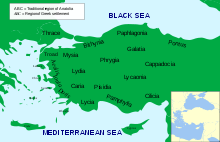Ionia
Ionia (Ancient Greek Ἰωνία or Ἰωνίη, Latin Ionia) is the name, dating back to the Greek tribe of the Ionians, of an ancient landscape on the western coast of Asia Minor, modern Turkey.
The region extended roughly from Smyrna in the north, to the region north of Halicarnassus, including the offshore islands (Chios, Samos). The Greek Ionians settled in the Aegean region at the end of the 2nd millennium BC. According to Herodotus, however, these fragmented tribes did not develop a sense of community until they reached Asia Minor. The name of the Ionians subsequently carried over to the "Ionians" who remained in the motherland. Important cities included Ephesus, Miletus, and Smyrna. The cities flourished through trade and also formed alliances among themselves, such as the Ionian League.
In Ionia developed some of the most important artistic styles of the Greeks. The name Ionia is also associated with the so-called Ionian Enlightenment in the philosophical field. In the 6th and 5th centuries BC, Ionia produced personalities such as Thales of Miletus, Anaximander or Heraclitus.
Around the middle of the 6th century BC, Ionia first came under the control of the Lydians, and around 546 under the rule of the Persians. In 500 BC there was the so-called Ionian Revolt, which ended with the intervention of Athens and the beginning of the Persian Wars. The west coast of Asia Minor, and with it Ionia, was liberated as a result of Greek victories in the 470s. However, Ionia fell back to the Persians in the so-called Royal Peace of 386 BC. It was not until Alexander the Great began his conquest of the Persian Empire that Ionia became Greek again. In the following centuries it remained fiercely contested between the Diadochi (Alexander's successors). It eventually became part of smaller state formations (part of the Empire of Pergamum) until it was absorbed into the Roman province of Asia after 133 BC. After 395 AD, Ionia was part of the Eastern Roman or Byzantine Empire. The name Ionia continued to be used later, sometimes in an anachronistic manner. The countryside was conquered by the Seljuks in the 11th century, reverted to Byzantium shortly thereafter until the 14th century, and then finally absorbed into the Ottoman Empire or what later became Turkey.
The name Ionia, via Hebrew and Arabic, became the name for Greece in a number of languages of the Islamic world, which is referred to in Arabic, Persian, and Urdu as یونان yūnān, and in Hebrew as יָוָן jawan. In Turkic languages and in Kurdish, the Turkish form Yunanistan is common.

Asia Minor Landscapes

Ionia (on the west coast of present-day Turkey; ancient Ionian cities are blue)
See also
- List of Ionian city foundations
Search within the encyclopedia